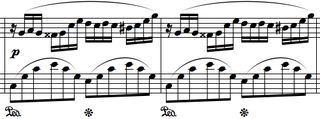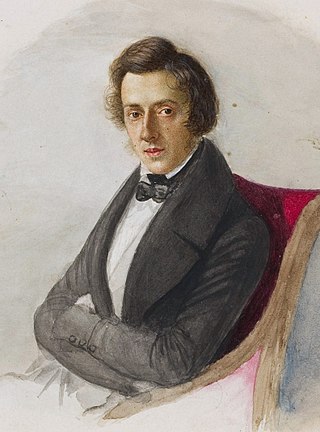Ternary form, sometimes called song form, is a three-part musical form consisting of an opening section (A), a following section (B) and then a repetition of the first section (A). It is usually schematized as A–B–A. Prominent examples include the da capo aria "The trumpet shall sound" from Handel's Messiah, Chopin's Prelude in D-Flat Major "Raindrop", and the opening chorus of Bach's St John Passion.

The Waltz in D-flat major, Op. 64, No. 1, sometimes known as "Valse du petit chien", and popularly known in English as the Minute Waltz, is a piano waltz by Polish composer and virtuoso Frédéric Chopin. It is dedicated to the Countess Delfina Potocka.

Frédéric Chopin's Fantaisie-Impromptu in C♯ minor, Op. posth. 66, WN 46 is a solo piano composition. It was composed in 1834 and published posthumously in 1855 despite Chopin's instruction that none of his unpublished manuscripts be published. The Fantaisie-Impromptu is one of Chopin's most frequently performed and popular compositions.

Étude Op. 10, No. 12 in C minor, known as the "Revolutionary Étude" or the "Étude on the Bombardment of Warsaw", is a solo piano work by Frédéric Chopin written c. 1831, and the last in his first set, Études, Op. 10, dedicated "à son ami Franz Liszt". The autographed edition is located in the archive of Stiftelsen Musikkulturens Främjande in Stockholm.
The Waltz in C♯ minor is a piano waltz composed by Frédéric Chopin in 1847, the second work of his opus 64 and the companion to the "Minute Waltz". Chopin dedicated this Waltz to Madame Nathaniel de Rothschild.

The Piano Sonata No. 2 in B♭ minor, Op. 35, is a piano sonata in four movements by Polish composer Frédéric Chopin. Chopin completed the work while living in George Sand's manor in Nohant, some 250 km (160 mi) south of Paris, a year before it was published in 1840. The first of the composer's three mature sonatas, the work is considered to be one of the greatest piano sonatas of the literature.

The Polonaise in A♭ major, Op. 53 is a solo piano piece composed by Frédéric Chopin in 1842 The piece is published in 1843, and is one of Chopin's most admired compositions and has long been a favorite of the romantic piano repertoire. Pianist Arthur Rubinstein once called it "the composition which is the closest to my heart." The piece requires exceptional piano skills and great virtuosity to be interpreted at a high degree of proficiency. It is also very physically demanding, and according to his student Adolphe Gutmann, Chopin played it more gently than most performers. The polonaise was dedicated to Auguste Léo, a German banker and friend of Chopin.

The Nocturnes, Op. 9 are a set of three nocturnes for solo piano written by Frédéric Chopin between 1831 and 1832, published in 1832, and dedicated to Madame Marie Pleyel. These were Chopin's first published set of nocturnes. The second nocturne of the work is often regarded as Chopin's most famous piece.
The Ballade No. 2 in F major, Op. 38 is a ballade for solo piano by Frédéric Chopin, completed in 1839. A typical performance lasts six to eight minutes.

Étude Op. 10, No. 6, in E♭ minor, is a study for solo piano composed by Frédéric Chopin in 1830. It was preceded by the relative key. It was first published in 1833 in France, Germany, and England as the sixth piece of his Études, Op. 10. The tempo Andante in 6
8 and con molto espressione indicate a more moderate playing speed than Chopin's other études with the exception of Op. 10, No. 3 and Op. 25, No. 7. This étude focuses on expressivity and chromatic structuring of the melody as well as polyphonic texture.
The Polonaise in C-sharp minor, Op. 26 No. 1 and the Polonaise in E-flat minor, Op. 26 No. 2 were composed by Frédéric Chopin in 1836. Both of them were dedicated to Josef Dessauer. These were his first published polonaises.
The Polonaises Op. posth[umous] include Frédéric Chopin's polonaises that were not given opus numbers.
The Mazurkas, Op. 6 are Frédéric Chopin's first set of mazurkas published during his lifetime. They were composed in 1830–1831 and were published in 1832. The set was dedicated to Grafin Pauline Plater.

The Nocturnes, Op. 55 are a set of two nocturnes for solo piano written by Frédéric Chopin. They are his fifteenth and sixteenth installations in the genre, and were composed between 1842 and 1844, and published in August 1844. Chopin dedicated them to his pupil and admirer Mademoiselle Jane Stirling.

Mazurkas, Op. 59 are a set of three Mazurkas for solo piano by Frédéric Chopin. The set was composed and published in 1845.

Mazurkas, Op. 33 are a set of four Mazurkas for piano by Frédéric Chopin, composed and published in 1838.

Mazurkas, Op. 17 is a set of four mazurkas for solo piano by Frédéric Chopin, composed in 1832–1833 and published in 1834. The set was dedicated to Lina Freppa.
The Mazurkas, Op. 7 are a set of five mazurkas by Frédéric Chopin. The mazurkas were mostly written in 1830–1831 and were published in 1832. This is the only set of Chopin's mazurkas that contains 5 pieces; all the composer's other published sets consist of either 3 or 4 mazurkas each. It is dedicated to Paul Emile Johns.
Alexander Scriabin's 24 Preludes, Op. 11 is a set of preludes composed in the course of eight years between 1888–96, being also one of Scriabin's first published works with M.P. Belaieff in 1897, in Leipzig, Germany, together with his 12 Études, Op. 8 (1894–95).









